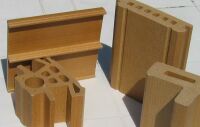 Hackwell Group suggests that annual production growth rates to 2009 will fall just short of ten per cent, rising from its 2005 total of 99,288 tonnes to nearly 145,000 tonnes per year, worth about €290M.
Hackwell Group suggests that annual production growth rates to 2009 will fall just short of ten per cent, rising from its 2005 total of 99,288 tonnes to nearly 145,000 tonnes per year, worth about €290M.
The extraordinary growth in sales of products made from mixtures of wood flour and plastics in North America has been the envy of European producers for ten years. The materials contain a good deal of wood filler (typically 40 to 80%) and yet their outdoor durability is more like that of plastics than wood. As a result the relatively high purchase price of WPC articles is offset by low outdoor maintenance costs. Products can be extruded like plastics, without expensive wood working operations, and can be co-extruded or veneered.
At last there are signs that the European market is taking off. In their second report on the European market, which comes in both a full standard edition and a much shorter one*, the UK based Hackwell Group highlights the considerable variety of wood plastics composites (WPC) products already available on this side of the Atlantic. Hackwell suggests that annual production growth rates to 2009 will fall just short of ten per cent. By then, European production will have risen from its 2005 total of 99,288 tonnes to nearly 145,000 t/y. This will make the total output worth about €290M. Faster growth is likely to occur if larger companies with more resources enter the market.
The automotive industry is easily the biggest user of WPC in Europe at the moment, with well over half the total consumption. The situation is very different elsewhere and vehicles account for as little as 7% of consumption worldwide WPC sales. In future, Hackwell expects a few European automotive supplier companies to be diverted to natural fibres such as flax and hemp.
On the other hand there is great scope for growth in WPC sales in construction and furniture. Construction is already the second largest sector after automotive. Although few furniture products are available yet, the number of companies developing furniture components made of WPC is much greater than when Hackwell last reported in 2003, and IPT in Germany has demonstrated the rotational moulding of a WPC chair.
Sales are also expected in infrastructure applications (such as highway sound barriers and waterfront fixtures) areas normally made of wood. Injection mouldings of WPC will offer the advantages of a popular natural material and a much reduced dependence on oil-based resin for a wide variety of products. (The most popular resin for WPC in Europe is virgin polypropylene, whereas the global preference is for polyethylene, often recycled. PVC is used by four or five manufacturers in Europe).
Leading European WPC manufacturers include Tech-Wood, PPT, Polyplank, Kosche and Deceuninck, among others. There is a growing concentration of producers in German speaking countries. Several European companies offer WPC in pellet form at under €1 per kg.
Decking has been far the biggest engine of growth for WPC in the USA and the absence of a strong European decking market has held the WPC industry back. Nevertheless a number of European countries are now showing interest in decking, which had already become the leading WPC product in Europe outside the automotive industry by 2004, as the figure shows. (The Hackwell Report contains data for 2005, and was completed early in 2006).
Hackwell finds that the volume of imports of WPC from the US, China, Malaysia and elsewhere is not yet large, and Europe has a small export trade so overall consumption figures for Europe do not differ very much from those for production.
It is not yet clear which of many other applications will become firmly established but siding or cladding, fencing and interior construction items are contenders. The WPC window market in the US is being developed but its European equivalent is dominated by PVC and already largely saturated. Improvements in the strength of WPC can be expected over the next two or three years to help its market penetration in a number of areas. Technical standards are being developed for WPC.
*The European Wood Plastics Composites Market 2006, Hackwell Group
Source
NetComposites.com April 06, 2006.
Share
Renewable Carbon News – Daily Newsletter
Subscribe to our daily email newsletter – the world's leading newsletter on renewable materials and chemicals









